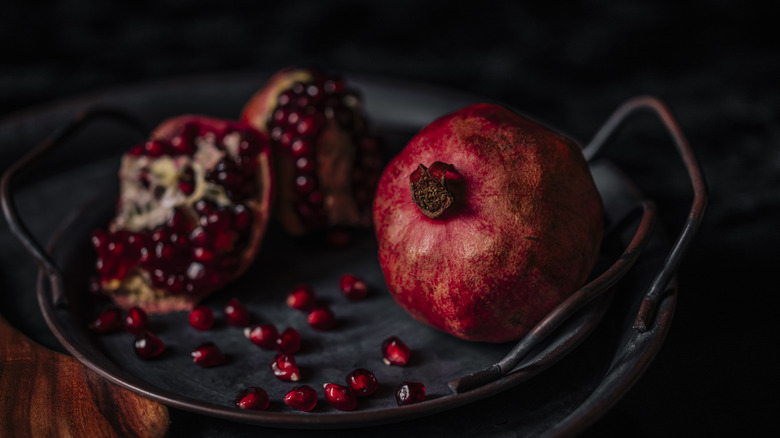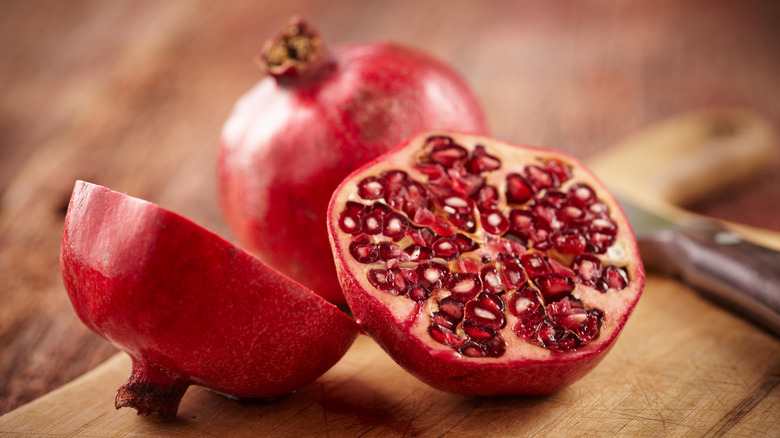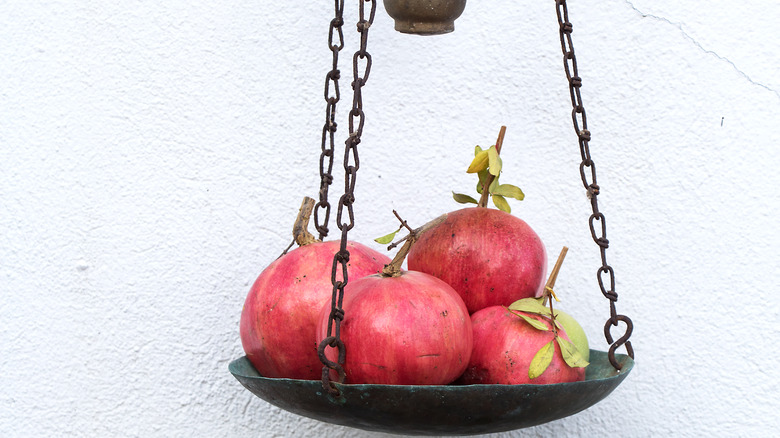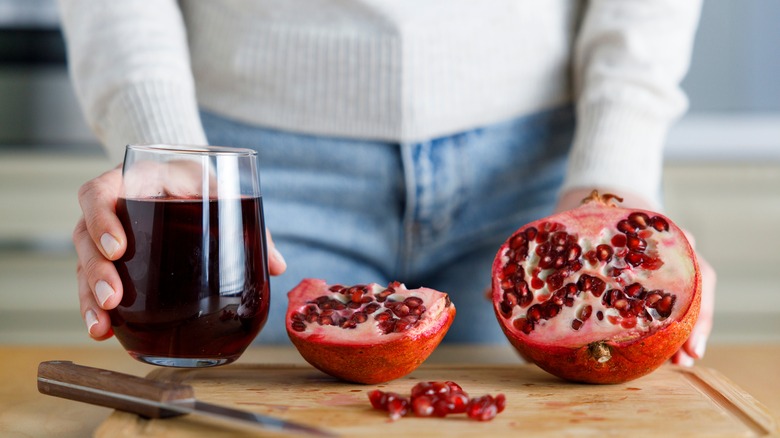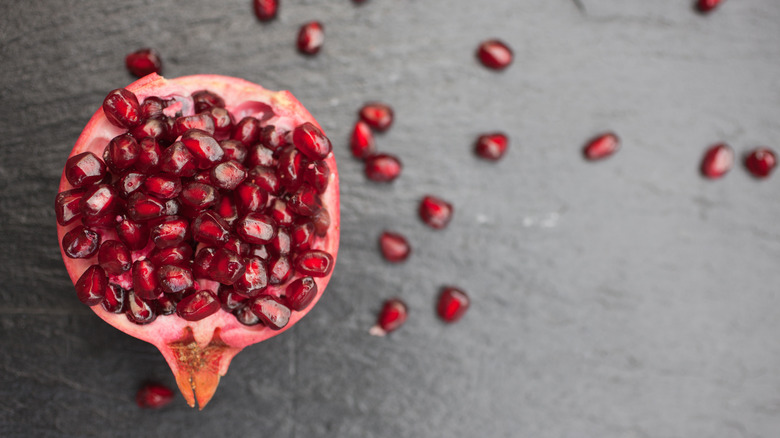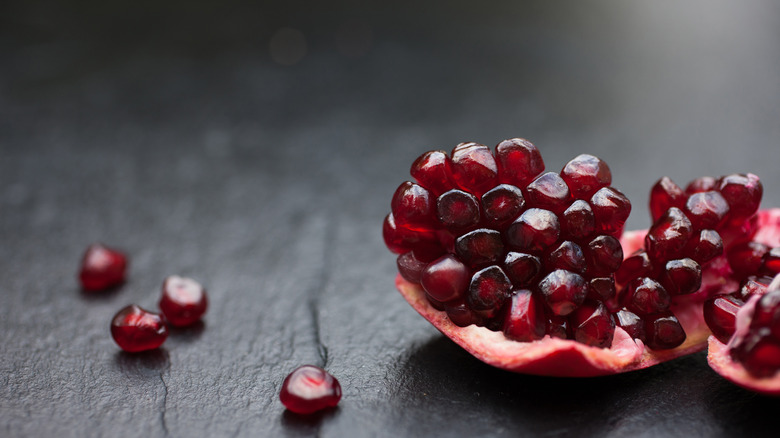The Best Ways To Tell If Pomegranates Are Ripe
No, a bite from the pomegranate fruit won't doom you to spend a good chunk of the year in the underworld. Not everyone can be Persephone. This sumptuous red fruit generally has a thick skin with a white membrane interior that is filled with juicy pomegranate seeds. When ripe, pomegranates are unmatched, as the seeds contain a deep red juice that has a sweet, somewhat sour taste with a crunch that makes them the perfect topping for yogurt or ice cream, or you can eat them on their own. But breaking into an unripe pomegranate might just make you want to take a trip to see Hades.
An unripe pomegranate is disappointing, to say the least. If a pomegranate is opened before it is fully ripe, the fruit will not be juicy, nor will it have that signature sweet taste. But how, exactly, can you tell if your pomegranate is ripe? The ripeness of a pomegranate isn't as easy to decipher as an apple, for example, due to its thick skin; and the desired part of its interior (the seeds) are not observable from the outside.
This doesn't mean that you'll have to dive into your pomegranates blindly. There are several ways to tell if your pomegranate is ripe for eating, or if it's best left on the produce aisle (or kitchen counter). So, next time you're after a pomegranate, follow these tips and you won't have to risk an unripe fruit.
Checking the color
Perhaps one of the easiest ways to make sure your pomegranate is ripe is by checking its color. Typically, most pomegranates sold in grocery stores in the United States are red. And generally, a ripe pomegranate will be dark red on the exterior. You should avoid pomegranate fruits with green spots, as this indicates an unripe fruit.
There are a variety of pomegranate types that vary in color, such as pink, yellow, and orange. For this reason, you can't rely too heavily on exterior color to indicate ripeness, especially if you are eating a less common variety of pomegranate. However, your fruit should have an even and vibrant color. If your fruit is mostly green or has significant green coloring, your pomegranate most likely isn't ripe yet.
But this doesn't mean that you should toss your seeded fruit, as pomegranates can ripen on the counter. Simply keep your unripe pomegranate on the counter for several days, until it has achieved the perfect color.
Weighing in
Another way of determining whether your pomegranate is ripe for eating is by gauging its weight. A perfectly ripe pomegranate should feel heavy, as this indicates that the seeds inside are perfectly juicy. After all, it is the juicy seeds that you're after when you reach for a pomegranate, and there is nothing so disappointing as cutting into a pomegranate and finding that the interior lacks the key component that makes the fruit so delicious.
So, make sure to pick up your pomegranate at the grocery store and feel it in your hand. The fruit should feel heavy for its size. Ripe pomegranates also feel dense, not hollow or light. Although this guidance isn't exactly precise, once you've got the hang of how a perfectly ripe pomegranate feels in your hand, it will soon be easy to tell a ripe pomegranate from one that is still green at the stem, so to speak.
A matter of sound
Of course, pulling out the scale isn't necessary when weighing whether or not you should cut into that pomegranate. Or perhaps you just want to be extra sure that your fruit is ripe, so that your fruit doesn't go to waste, and you don't have to make yet another trip to the grocery store. To tell if your fruit is perfectly ripe for a pomegranate-glazed salmon recipe or adding to an apple cobbler, you can always tap it out. That's right, your pomegranate's sound can be a great indication of its ripeness.
A ripe pomegranate will make a metallic sound when flicked or tapped. In contrast, an unripe pomegranate will sound hollow on the inside, as the inside has not yet reached its juicy potential. And although it can be tricky to discern the exact sound of your pomegranate, using this trick in conjunction with your fruit's weight and color can help you to fully gauge its ripeness.
Shape and crown
Perhaps one of the biggest indicators of pomegranate ripeness, however, is its shape. Though most pomegranates tend to have a round shape, there is one key indication that a pomegranate is ready to eat. A ripe pomegranate will have a more boxy shape than an unripe pomegranate, and it will have visible seams that give the fruit a more structured look. This implies that the seeds within the fruit are perfectly juicy. This doesn't mean that your fruit will be square-shaped, but it should not be perfectly round.
Another indicator of ripeness found in the shape of your fruit is the crown. The crown of a pomegranate, or calyx, is located on the bottom of the fruit and resembles a crown (go figure). When a pomegranate is not yet ripe, the crown will appear straight or bent outward, but as the fruit ripens, it curls inwards. And this is the crown that you will want to pick out when selecting your fruit.
Texture is key
However, if you want to be sure that your fruit is ripe, you can always check the skin of your pomegranate. The texture of your fruit is a great indicator of whether or not the fruit is ready to be eaten. A ripe pomegranate fruit will be completely smooth, with no bumps on its surface.
Additionally, you can do the fingernail test on your pomegranate to see if it is juicy and ready for eating. All you need to do is scratch the skin of your fruit. If you can easily scratch it with light pressure, then your fruit is ripe and ready. If, however, it is difficult to scratch, then your fruit has not yet ripened. This is because a ripe pomegranate has softer, more tender skin that yields a more juicy interior, while a harder outer shell indicates that the fruit inside has not yet reached its full potential. Next time you reach for a pomegranate at the grocery store, make sure to use the indicators above to ensure that your fruit is truly ready to be enjoyed.
